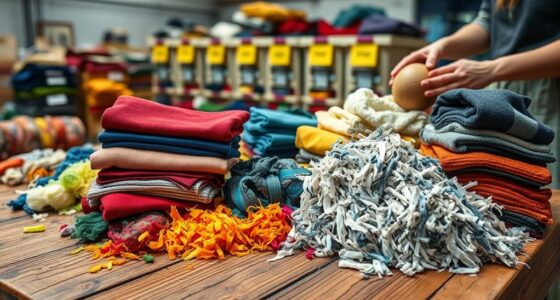Blockchain technology allows you to trace your T-shirt from raw materials on the farm to the store shelf. It creates a transparent, tamper-proof record of every step in the supply chain, verifying sustainable sourcing, fair labor practices, and ethical production. This open ledger helps you make more informed and responsible choices about the clothing you buy. Continue exploring to discover how blockchain is reshaping the future of textile transparency and integrity.
Key Takeaways
- Blockchain creates a transparent, tamper-proof record of each stage from raw material sourcing to retail delivery.
- It verifies sustainable practices and fair labor conditions throughout the textile supply chain.
- Consumers can trace their clothing’s origin, ensuring ethical production and authentic products.
- Companies benefit from improved accountability, reduced fraud, and streamlined logistics via blockchain integration.
- Future innovations will make textile supply chain tracking more accessible, reliable, and supportive of sustainable fashion.

Have you ever wondered how blockchain technology can transform the textile industry? It’s an exciting development that can revolutionize how you trace your favorite T-shirts from raw materials to retail shelves. Blockchain offers a way to establish transparent, tamper-proof records along the entire supply chain, making it easier for brands and consumers to verify where and how fabrics are sourced. This technology promotes sustainable sourcing by providing detailed insights into each step of production, ensuring that environmental and ethical standards are met. When you buy a garment, you want to know it was produced responsibly. Blockchain makes this possible by creating an open ledger that records every transaction and movement, from farms to factories to stores.
Blockchain enables transparent, tamper-proof tracking of textiles from farm to store, ensuring responsible sourcing and ethical manufacturing.
Supply chain transparency becomes much more than just a buzzword with blockchain. It empowers you to see the journey of a textile product in real time. For instance, you can confirm that organic cotton was used or that fair labor practices were upheld during manufacturing. This level of transparency helps prevent issues like counterfeit products or unethical labor practices, which can sometimes be hidden behind complex supply chains. By accessing this verified data, you gain confidence in the sustainability claims brands make. You no longer have to rely solely on marketing promises; blockchain provides concrete proof of a product’s origin and production methods.
For companies, implementing blockchain means a shift toward more responsible practices. It encourages them to prioritize sustainable sourcing, knowing that their supply chain is fully traceable. This accountability can lead to more ethical partnerships and a reduced environmental footprint. Additionally, blockchain can streamline logistics, reduce paperwork, and minimize fraud, ultimately lowering costs and improving efficiency. For you, this means more reliable products and a clearer understanding of what’s behind the clothes you wear.
In essence, blockchain transforms the textile industry into a more honest and sustainable space. It bridges the gap between consumers and manufacturers by providing an accessible, immutable record of product history. When you choose a garment with blockchain-backed transparency, you’re supporting brands committed to ethical practices and sustainability. It’s a way to make more informed decisions, knowing that your purchase contributes to a more transparent and responsible industry. As blockchain continues to evolve, expect even more innovations that will make your wardrobe more sustainable and ethically sourced, one verified step at a time. Cost-effective production methods can help reduce the overall environmental impact of textile manufacturing.
Frequently Asked Questions
How Secure Is Blockchain Data Against Hacking?
You might wonder how secure blockchain data is against hacking. Blockchain technology considerably reduces cybersecurity risks because it uses data encryption and decentralized ledgers, making it tough for hackers to manipulate information. While no system is completely invulnerable, blockchain’s cryptographic protections and distributed nature make unauthorized access difficult. So, you can trust that your data stays safe, but staying aware of potential vulnerabilities is always wise.
Can Blockchain Improve Sustainability in Textile Production?
You can see that blockchain has the potential to improve sustainability in textile production by enhancing supply chain transparency and ensuring ethical sourcing. With blockchain, you get clear, tamper-proof records that verify where materials come from and how they’re made. This encourages brands and manufacturers to follow sustainable practices, reduces fraud, and promotes accountability, making the entire process more environmentally and socially responsible from farm to closet.
What Are the Costs of Implementing Blockchain in Textiles?
When considering blockchain, you should do a thorough cost analysis to understand the expenses involved. Implementation challenges include high initial setup costs, technical complexity, and training staff. You might face ongoing costs for maintenance and updates. While blockchain can boost transparency and sustainability, it’s crucial to weigh these costs carefully to determine if the benefits outweigh the investment. Proper planning helps manage expenses and minimizes potential hurdles.
How Does Blockchain Ensure Data Privacy for Consumers?
Blockchain guarantees your data privacy by using strong data encryption, which keeps your information secure and unreadable to unauthorized parties. Access controls are also implemented, allowing only authorized individuals to view or modify the data. You benefit from these measures because they protect your personal details and transaction history, giving you confidence that your information remains private and secure within the blockchain system.
What Challenges Exist in Adopting Blockchain Globally?
Getting the ball rolling on global blockchain adoption isn’t a walk in the park. You face hurdles like cross border regulations, which vary widely and can slow things down, and uneven technological infrastructure, making seamless integration tough. Without a unified approach, businesses risk hitting walls. To succeed, you need to navigate these complexities carefully, bridging gaps and ensuring compliance across regions for blockchain to truly thrive worldwide.
Conclusion
By embracing blockchain for textiles, you empower transparency, traceability, and trust. This tech transforms your textile journey from farm to fashion, fostering fairness and fortifying your confidence. With blockchain’s boundless benefits, you become a champion of clean, clear, and conscious clothing choices. So, step into the smart, secure, and sustainable future of fashion—where your choices matter and your clothes tell a trustworthy tale. Make the move today and master the magic of blockchain in textiles.









